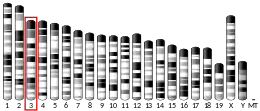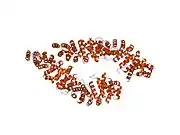BCL9
B-cell CLL/lymphoma 9 protein is a protein that in humans is encoded by the BCL9 gene.[5][6]
Function
BCL9, together with its paralogue gene BCL9L (BCL9 like or BCL9.2), have been extensively studied for their role as transcriptional beta-catenin cofactors, fundamental for the transcription of Wnt target genes.[7]
Recent work, using the mouse (Mus musculus) and Zebrafish (Danio rerio) as model organisms, identified an ancient role of BCL9 and BCL9L as key factors required for cardiac development.[8] This work emphasises the tissue-specific nature of the Wnt/β-catenin mechanism of action, and implicates alterations in BCL9 and BCL9L in human congenital heart defects.
BCL9 and BCL9L have been shown to take part in other tissue-specific molecular mechanisms, showing that their role in the Wnt signaling cascade is only one aspect of their mode of action.[9]
Clinical significance
BCL9 is associated with B-cell acute lymphoblastic leukemia. It may be a target of translocation in B-cell malignancies with abnormalities of 1q21. The overexpression of BCL9 may be of pathogenic significance in B-cell malignancies.[6]
BCL9 and BCL9L are potential clinical targets for human cancers; for instance, the gene expression changes that they promote is associated with a poor outcome in colorectal cancer.[10]
Like BCL2, BCL3, BCL5, BCL6, BCL7A, and BCL10, it has clinical significance in lymphoma.
Common variations in the BCL9 gene, which is in the distal area, confer risk of schizophrenia and may also be associated with bipolar disorder and major depressive disorder.[11]
BCL9, together with the paralogue protein BCL9l and PYGO2 also have cytoplasmic functions during tooth development and is particularly important for the formation of enamel. Mice lacking both Pygo1 and Pygo2 or both Bcl9 and Bcl9l develop teeth, a process that requires Wnt/β-catenin transcriptional regulation, but the enamel is structurally disorganized and contains less iron than teeth from control mice. Bcl9, Bcl9l, and Pygo2 are present in the cytoplasm of ameloblasts, the cells that secrete enamel proteins, and colocalize in these cells with amelogenin, the main component of enamel, encoded by the AMELX gene, which has been already implicated as a causative factor of Amelogenesis Imperfecta in humans. Bcl9 interacts with amelogenin and proteins involved in exocytosis and vesicular trafficking, suggesting that these proteins function in the trafficking or secretion of enamel proteins. Therefore, Bcl9, Bcl9l, and Pygo2 have cytoplasmic functions distinct from their roles as transcriptional cofactors downstream of Wnt signaling.[12] This new discovery might improve our understanding for the treatment of human caries.[13]
Related gene problems
References
- GRCh38: Ensembl release 89: ENSG00000116128 - Ensembl, May 2017
- GRCm38: Ensembl release 89: ENSMUSG00000038256 - Ensembl, May 2017
- "Human PubMed Reference:". National Center for Biotechnology Information, U.S. National Library of Medicine.
- "Mouse PubMed Reference:". National Center for Biotechnology Information, U.S. National Library of Medicine.
- Willis TG, Zalcberg IR, Coignet LJ, Wlodarska I, Stul M, Jadayel DM, Bastard C, Treleaven JG, Catovsky D, Silva ML, Dyer MJ (Mar 1998). "Molecular cloning of translocation t(1;14)(q21;q32) defines a novel gene (BCL9) at chromosome 1q21". Blood. 91 (6): 1873–81. doi:10.1182/blood.V91.6.1873. PMID 9490669.
- "Entrez Gene: BCL9 B-cell CLL/lymphoma 9".
- Mosimann C, Hausmann G, Basler K (Apr 2009). "Beta-catenin hits chromatin: regulation of Wnt target gene activation". Nature Reviews. Molecular Cell Biology. 10 (4): 276–86. doi:10.1038/nrm2654. PMID 19305417.
- Cantù, Claudio; Felker, Anastasia; Zimmerli, Dario; Prummel, Karin; Cabello, Elena; Chiavacci, Elena; Mendez-Acevedo, Kevin; Kirchgeorg, Lucia; Sibylle, Burger; Ripoll, Jorge; Valenta, Tomas; Hausmann, George; Vilain, Nathalie; Aguet, Michel; Burger, Alexa; Panáková, Daniela; Basler, Konrad; Mosimann, Christian (1 November 2018). "Mutations in Bcl9 and Pygo genes cause congenital heart defects by tissue-specific perturbation of Wnt/β-catenin signaling". Genes & Development. 32 (21–22): 1443–1458. doi:10.1101/gad.315531.118. PMC 6217730. PMID 30366904.
- Cantù C, Zimmerli D, Hausmann G, Valenta T, Moor A, Aguet M, Basler K (Sep 2014). "Pax6-dependent, but β-catenin-independent, function of Bcl9 proteins in mouse lens development". Genes & Development. 28 (17): 1879–84. doi:10.1101/gad.246140.114. PMC 4197948. PMID 25184676.
- Moor AE, Anderle P, Cantù C, Rodriguez P, Wiedemann N, Baruthio F, Deka J, André S, Valenta T (2015-12-01). "BCL9/9L-β-catenin Signaling is Associated With Poor Outcome in Colorectal Cancer". EBioMedicine. 2 (12): 1932–1943. doi:10.1016/j.ebiom.2015.10.030. PMC 4703711. PMID 26844272.
- Li J, Zhou G, Ji W, Feng G, Zhao Q, Liu J, Li T, Li Y, Chen P, Zeng Z, Wang T, Hu Z, Zheng L, Wang Y, Shen Y, He L, Shi Y (2011). "Common variants in the BCL9 gene conferring risk of schizophrenia". Archives of General Psychiatry. 68 (3): 232–40. doi:10.1001/archgenpsychiatry.2011.1. PMID 21383261.
- Cantù C, Pagella P, Shajiei TD, Zimmerli D, Valenta T, Hausmann G, Basler K, Mitsiadis TA (2017-02-07). "A cytoplasmic role of Wnt/β-catenin transcriptional cofactors Bcl9, Bcl9l, and Pygopus in tooth enamel formation". Sci. Signal. 10 (465): eaah4598. doi:10.1126/scisignal.aah4598. ISSN 1945-0877. PMID 28174279.
- "Mutated genes lead to tooth enamel defects that increase risk of caries". News-Medical.net. 2017-02-07. Retrieved 2017-02-08.
Further reading
- Busson-Le Coniat M, Salomon-Nguyen F, Dastugue N, Maarek O, Lafage-Pochitaloff M, Mozziconacci MJ, Baranger L, Brizard F, Radford I, Jeanpierre M, Bernard OA, Berger R (Dec 1999). "Fluorescence in situ hybridization analysis of chromosome 1 abnormalities in hematopoietic disorders: rearrangements of DNA satellite II and new recurrent translocations". Leukemia. 13 (12): 1975–81. doi:10.1038/sj/leu/2401587. PMID 10602418.
- Kramps T, Peter O, Brunner E, Nellen D, Froesch B, Chatterjee S, Murone M, Züllig S, Basler K (Apr 2002). "Wnt/wingless signaling requires BCL9/legless-mediated recruitment of pygopus to the nuclear beta-catenin-TCF complex" (PDF). Cell. 109 (1): 47–60. doi:10.1016/S0092-8674(02)00679-7. PMID 11955446.
- Knoll A, Dvorák J, Rohrer GA, Cepica S (Apr 2002). "Linkage and cytogenetic mapping of the BCL9 gene to porcine chromosome 4". Animal Genetics. 33 (2): 162–3. doi:10.1046/j.1365-2052.2002.0831e.x. PMID 12047235.
- Townsley FM, Thompson B, Bienz M (Feb 2004). "Pygopus residues required for its binding to Legless are critical for transcription and development". The Journal of Biological Chemistry. 279 (7): 5177–83. doi:10.1074/jbc.M309722200. PMID 14612447.
- Hoffmans R, Basler K (Sep 2004). "Identification and in vivo role of the Armadillo-Legless interaction". Development. 131 (17): 4393–400. doi:10.1242/dev.01296. PMID 15294866.
- Beausoleil SA, Jedrychowski M, Schwartz D, Elias JE, Villén J, Li J, Cohn MA, Cantley LC, Gygi SP (Aug 2004). "Large-scale characterization of HeLa cell nuclear phosphoproteins". Proceedings of the National Academy of Sciences of the United States of America. 101 (33): 12130–5. doi:10.1073/pnas.0404720101. PMC 514446. PMID 15302935.
- Sampietro J, Dahlberg CL, Cho US, Hinds TR, Kimelman D, Xu W (Oct 2006). "Crystal structure of a beta-catenin/BCL9/Tcf4 complex". Molecular Cell. 24 (2): 293–300. doi:10.1016/j.molcel.2006.09.001. PMID 17052462.
- Hoffmans R, Basler K (Jan 2007). "BCL9-2 binds Arm/beta-catenin in a Tyr142-independent manner and requires Pygopus for its function in Wg/Wnt signaling". Mechanisms of Development. 124 (1): 59–67. doi:10.1016/j.mod.2006.09.006. PMID 17113272.







